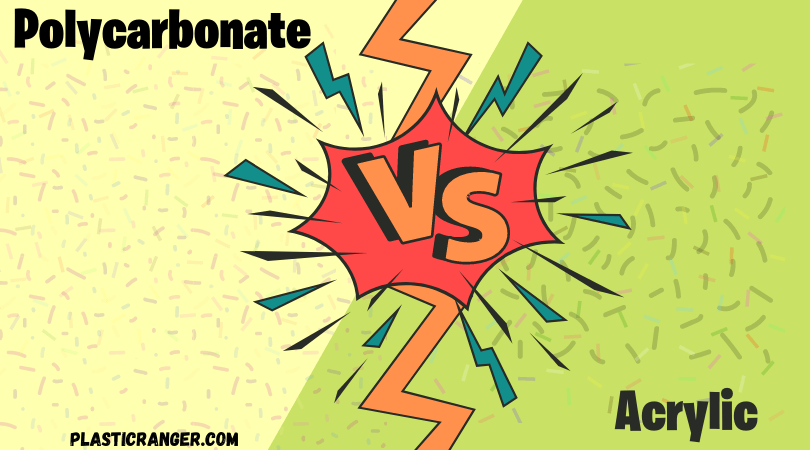Polycarbonate VS Acrylic
Polycarbonate is an excellent choice for demanding applications, such as bullet-resistant windows, due to its superior resilience compared to acrylic. Acrylic, on the other hand, has a higher level of transparency and a glossy finish, making it ideal for use in display cases. However, acrylic is more prone to cracking, whereas polycarbonate is easier to scratch.
Acrylic vs Polycarbonate is a long-overdue debate between manufacturers looking for transparent material.
However, both materials are often compared with each other because of their similar appearance and the frequent need to utilize one of them for see-through applications.
Both Polycarbonate and Acrylic are 50% lighter than comparably sized glass, but strength is not compromised in both plastics.
They’re both more robust than glass (Acrylic is roughly 17 times more impact-resistant than glass, while polycarbonate is around 200 times stronger than glass), and it is also effortless to clean both.
Below I have mentioned the pros and cons, general applications, and insights on both materials.
Acrylic Plastic
Acrylic is marketed and traded under trademark names like Plexiglass, lucite, Policril, Perspex, Vitroflex, Gavireli, R-Cast, Per-Clex, Altuglas, Polycast, Optix, Oroglass, Acrylite, Acrylplast, Plazcryl, and Acrylex.
“Plexiglass” is the most popular acrylic plastic trademark, and its name is often taken interchangeably with acrylic plastic.
Acrylic Properties
- Durable against dents and scratches.
- More cost-effective than glass and polycarbonate.
- Sheets can be polished smoothly.
- Unsusceptible to discoloration from the sun.
- 17 times more impact resistant than glass.
- Continuous working temperature – 82°C (180F).
- Outstanding chemical resistance to all solvents.
- Lightweight.
- High optical clarity.
- Decent weatherablity and UV resistance.
- Easy to cut and heat bent.
- Shiny surface.
- Available in a variety of colors.
- 92% light transmittance in all thicknesses, which is better than glass.
| Property | Value |
| Density | 1.17-1.20 g/cm³ |
| Tensile strength | 75-115 MPa |
| Young’s modulus | 2.3-3.0 GPa |
| Elongation at break | 2-10% |
| Flexural strength | 120-170 MPa |
| Impact strength | 0.17-0.82 J/m |
| Heat deflection temp | 70-100 °C |
| Melting point | 160-220 °C |
| Mold temperature | 70-90 °C |
| Transparency | Clear or translucent |
| Water absorption | <1% |
| Chemical resistance | Resistant to most acids, bases, and salts |
Acrylic Applications
- Insulations
- Craft projects
- Retail displays
- Windows and glass substitutes
- Optical lens
- Fashion accessories
- Animal and reptile enclosures
- Signage
- Light covers
- Medical implants and technologies
- Furniture
Interesting Read – UHMW Vs. Delrin: Which one is the Best?
Polycarbonate Plastic
Polycarbonate is trademarked as Lexan or Makrolon. The two major differences between polycarbonate and acrylic are the cost and impact strength.
Polycarbonate sheets are 35% costlier than acrylic, and although both materials are way stronger than glass, polycarbonate’s impact strength is unmatched by any thermoplastics available in the market.
Polycarbonate Properties
- 250 times stronger than glass and 30 times stronger than acrylic
- Available in bullet-resistant grades
- Low flammability
- 88% light transmittance
- Lightweight
- High resistance towards acids and chemicals like gasoline.
- Can be cold-formed or bent without heating
- Less rigidity and available in a variety of grades
- Continuous working temperature – 115 °C (240F)
| Property | Value |
| Density | 1.20-1.22 g/cm³ |
| Tensile strength | 55-75 MPa |
| Young’s modulus | 2.2-2.4 GPa |
| Elongation at break | 80-150% |
| Flexural strength | 90-120 MPa |
| Impact strength | 900-1200 J/m |
| Heat deflection temp | 130-140 °C |
| Glass transition temp | 147 °C |
| Transparency | Clear or translucent |
| Water absorption | <0.35% |
| Chemical resistance | Resistant to most acids, bases, and salts |
| Cooling | Part Cooling Fan Not Required |
Polycarbonate Applications
- Face Sheilds
- Protective glasses
- Roofing panels
- Greenhouse Windows
- Headlamp bezels
- Syringes
- Surgical instruments
- Thermometers
- Appliances (Coffee machines, trimmers, television, washing machines, etc.)
- Data storage
- Reusable drinking bottles
- Skylights
- Outdoor signs
- Construction materials
- Diffusers and light pipes of LEDs
Advantages and Disadvantages of Acrylic and Polycarbonate
| Advantages | Disadvantages | |
| Acrylic |
|
|
| Polycarbonate |
|
|
As we’ve gone through the difference between acrylic and polycarbonate, let’s understand why these plastics possess different properties and attributes.
What is Acrylic or Polycarbonate Are Made of?

Acrylic plastic and polycarbonate are both polymers and thermoplastics at that. A polymer is a material made from different molecules connected in long chains.
That’s why acrylic and polycarbonate look, feel, and act differently. Both are made differently, utilizing other molecules.
The entire process of making polymers is called polymerization.
In layman’s terms, polycarbonate is created by a reaction between bisphenol A and phosgene COCl2.
Talking about acrylic plastic is made by harmonizing methyl methacrylate.
Methyl methacrylate is generally caused by a reaction between acetone and sodium cyanide to produce acetone cyanohydrin.
This is then reacted with methyl alcohol to create methyl methacrylate finally.
These are the most common methods used to produce acrylic and polycarbonate.
However, other methods are used when materials with unique features are required, i.e., color, non-glare, static, anti-static, UV filtering, weatherability, etc.
Engaging Read – What is a Plastic Pallet? | The Definitive Guide
Polycarbonate VS Acrylic: Differences In Manufacturing Process
How are Acrylic Sheets Made?
Bulk polymerization is the most utilized process to manufacture acrylic, in which the monomer (methyl methacrylate) and the catalyst (generally organic peroxide) are spilled into a mold. The mold is closed and heated to produce the reaction that creates the acrylic plastic polymer. Later the molded acrylic sheets need to be cured. The thinner sheets are easier to cure; they generally take 10 to 12 to cure; However, the thicker acrylic sheets can take several days to cure themselves completely.
The molds are opened, and cooled, and the resulting sheets are immediately used to improve the quality of the final product.
The two most adapted methods for manufacturing acrylic plastic sheets are Batch cell and continuous bulk polymerization.
How are Polycarbonate Sheets are Made?
Polycarbonate is a versatile thermoplastic material with phenomenal machinability towards manufacturing techniques such as Injection molding, blow molding, extrusion, thermoforming, and more; however, for producing polycarbonate sheets, the ideal process is Extrusion.
The process begins with polycarbonate resin being fed into an extruder and melted at the desired temperature.
The molten polycarbonate is then forced through a die to produce parts with various widths, lengths, and thicknesses with uniform cross-sections.
The process can make polycarbonate sheets with different sizes, geometries, colors, high or low glosses, single or multiple layers, and smooth or textured surfaces.
Once the sheets are made using the extrusion process, they are further processed to get the final product.
Polycarbonate acrylic sheets are used in safety glasses, security barriers, medical devices, Electronics, auto parts, lenses, etc.
Interesting Read – Plastics Vs. Polymers | What are the Differences?
Polycarbonate VS Acrylic: Types of Sheets
Both materials have a wide range of differences in properties and applications, allowing the sheets to be produced in various shapes and forms depending on the applications. Below are the different types of sheets available:
| Acrylic | Polycarbonate |
| Clear | Clear |
| Light-diffusing | Tinted |
| Colored and Flouosent | Colored |
| Bullet Resistant | BulletProof |
| Mirrored | Mirrored |
| Abrasion-Resistant | Abrasion-Resistant |
| Anti-Static & Non-Glare | Anti-Static |
| UV Filtering & Transmitting | Multiwall |
| Black & White | FDA Approved |
| Block | Flame Retardant |
When looking at an acrylic or polycarbonate sheet, you will clearly see the difference in appearance because of the drastic differences between their physical and chemical properties.
FAQs
Frequently asked questions about acrylic vs polycarbonate are presented below, and we will explore them in more detail.
How can I tell apart polycarbonate and acrylic?
The difference is made by one critical formulation in polycarbonate, which is not present in acrylic. While formulating polycarbonate, a bluing agent is used, making the edge of polycarbonate blue, while the advantage of acrylic will look clear. However, they both look clear on the surface.
How long will polycarbonate last?
Although polycarbonate is very durable, UV protection treatment should still be given, preventing it from breaking down or turning pale or yellow. With adequate care, polycarbonate can last for 10-15 years. That’s way more than glass.
What are the disadvantages of acrylic?
The two main disadvantages of acrylic are that it is more liable to scratching than glass and poor heat resistance.
Is acrylic waterproof?
Although slightly water-resistant, it still can’t be considered entirely waterproof. However, additives can be added to give a boost to that property.
Is acrylic plastic terrible for the environment?
Acrylic has a significant negative impact on the environment. Theoretically, it can be recalled, but the recycling process is challenging and complicated. That means most acrylic is being released into the environment, severely affecting the oceans, flora, and fauna.
Suggested Read
- Plexiglass Vs. Acrylic | What are the Differences and Similarities?
- CPVC VS PVC | Difference Between PVC and CPVC
- LDPE Vs HDPE: What are the Differences and Similarities
- 7 Types of Plastics | An Helpful Illustrated Guide
- 6 Best Plastic Molding Techniques | A Complete Analysis
- Food Grade Plastic: The Best Plastics for Food Applications
- Which is the Best Acrylic Glue? | The Best Plexiglass Glue
The Conclusion
In conclusion, when choosing between polycarbonate and acrylic, one must consider the project requirements meticulously. Polycarbonate stands out for its superior strength and impact resistance, making it ideal for safety applications and demanding environments.
On the other hand, acrylic offers excellent optical clarity and is more cost-effective, but it is more prone to scratching.
Therefore, selecting the suitable material hinges on carefully assessing the inherent trade-offs between durability, aesthetics, and budget constraints.
If you enjoyed this article, please leave your feedback and opinions in the comment section.
Wishing you a wonderful day.
Take care.
Quick Navigation



Thank you for sharing this very informative article. Even though we are daily working with acrylic and polycarbonate products, the differences between these materials that make them unique are quite unnoticed. The article is well written and is up to the point. Working as a polycarbonate and acrylic supplier in Kuwait, I’ve found this article to be reliable. Expecting more helpful articles from your side.
Thanks for the feedback.
Really its awesome knowledge provider for a chemical trader like myself.
I appreciate your feedback.
I was looking for differences between UV absorption between the 2, but if a coating works then it’s not an issue. I am concerned about Bisphenol A and its thousands of other sister molecules that are persistent in the environment and imitates hormones in the human body. Polycarbonate lasting 10-15 years is not way more than glass, as glass can last thousands of years if not broken. I don’t understand that part. In “How are Acrylic Sheets Made?”, you left out hours in 10-12 to cure. In the “Polycarbonate VS Acrylic: Types of Sheets” section, I don’t know what UV Filtering & Transmitting, Black & White, Block and Multiwall mean. Lastly, how is acrylic more harmful than polycarbonate when PC uses chemicals like BPA? I found this article very informative and a good reference which is why I’m going kind of hard on you. It’s almost perfect and needs some work. Thank you.
In the 1st paragraph it was stated that polycarbonate is easier to scratch. In the conclusion it was stated that acrylic is more prone to scratching. So which is which?
acrylic is easier to scratch.